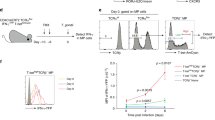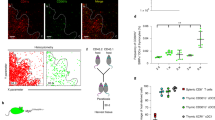Abstract
Dendritic cells (DCs) initiate and regulate immunity against foreign and self antigens. Here we identified more than 200 individual major histocompatibility complex class II–associated peptides on human DCs and found that mature DCs selectively upregulated the self peptide CLIP. CLIP cosegregated together with foreign antigenic peptides in tetraspan microdomains on the surface and localized to DC–T cell synapses. The increased representation of CLIP–major histocompatibility complex class II complexes favored polarization of autologous naive T cells toward the nonpolarized and T helper type 2 (TH2) phenotype. There was also a considerably higher TH2/TH1 ratio in H2-DM-deficient mice, which have a CLIPhi phenotype, in contrast to wild-type, CLIPlo mice. Thus, the self peptide CLIP on DCs qualifies as an endogenous regulator in priming of T helper cells by antagonizing the polarization toward the TH1 phenotype.
This is a preview of subscription content, access via your institution
Access options
Subscribe to this journal
Receive 12 print issues and online access
$209.00 per year
only $17.42 per issue
Buy this article
- Purchase on Springer Link
- Instant access to full article PDF
Prices may be subject to local taxes which are calculated during checkout







Similar content being viewed by others
References
Banchereau, J. et al. Immunobiology of dendritic cells. Annu. Rev. Immunol. 18, 767–811 (2000).
Cresswell, P. Invariant chain structure and MHC class II function. Cell 84, 505–507 (1996).
Riberdy, J.M., Newcomb, J.R., Surman, M.J., Barbosa, J.A. & Cresswell, P. HLA-DR molecules from an antigen-processing mutant cell line are associated with invariant chain peptides. Nature 360, 474–477 (1992).
Kropshofer, H., Hammerling, G.J. & Vogt, A.B. The impact of the non-classical MHC proteins HLA-DM and HLA-DO on loading of MHC class II molecules. Immunol. Rev. 172, 267–278 (1999).
Buus, S., Sette, A., Colon, S.M. & Grey, H.M. Autologous peptides constitutively occupy the antigen binding site on Ia. Science 242, 1045–1047 (1988).
Heath, W.R. & Carbone, F.R. Cross-presentation, dendritic cells, tolerance and immunity. Annu. Rev. Immunol. 19, 47–64 (2001).
Brocker, T. Survival of mature CD4 T lymphocytes is dependent on major histocompatibility complex class II-expressing dendritic cells. J. Exp. Med. 186, 1223–1232 (1997).
Viret, C., Wong, F.S. & Janeway, C.A., Jr. Designing and maintaining the mature TCR repertoire: the continuum of self-peptide:self-MHC complex recognition. Immunity 10, 559–568 (1999).
Wulfing, C. et al. Costimulation and endogenous MHC ligands contribute to T cell recognition. Nat. Immunol. 3, 42–47 (2002).
Stefanova, I., Dorfman, J.R. & Germain, R.N. Self-recognition promotes the foreign antigen sensitivity of naive T lymphocytes. Nature 420, 429–434 (2002).
Bhandoola, A. et al. Peripheral expression of self-MHC-II influences the reactivity and self-tolerance of mature CD4+ T cells: evidence from a lymphopenic T cell model. Immunity 17, 425–436 (2002).
Constant, S.L. & Bottomly, K. Induction of TH1 and TH2 CD4+ T cell responses: the alternative approach. Annu. Rev. Immunol. 15, 297–322 (1997).
Vogt, A.B., Spindeldreher, S. & Kropshofer, H. Clustering of MHC-peptide complexes prior to their engagement in the immunological synapse: lipid raft and tetraspan microdomains. Immunol. Rev. 189, 136–151 (2002).
Dongre, A.R. et al. In vivo MHC class II presentation of cytosolic proteins revealed by rapid automated tandem mass spectrometry and functional analyses. Eur. J. Immunol. 31, 1485–1494 (2001).
Fung-Leung, W.P. et al. Antigen presentation and T cell development in H2-M-deficient mice. Science 271, 1278–1281 (1996).
Martin, W.D. et al. H2-M mutant mice are defective in the peptide loading of class II molecules, antigen presentation, and T cell repertoire selection. Cell 84, 543–550 (1996).
Miyazaki, T. et al. Mice lacking H2-M complexes, enigmatic elements of the MHC class II peptide-loading pathway. Cell 84, 531–541 (1996).
Chen, X. et al. Regulated expression of human histocompatibility leukocyte antigen (HLA)-DO during antigen-dependent and antigen-independent phases of B cell development. J. Exp. Med. 195, 1053–1062 (2002).
Glazier, K.S. et al. Germinal center B cells regulate their capability to present antigen by modulation of HLA-DO. J. Exp. Med. 195, 1063–1069 (2002).
Denzin, L.K., Sant'Angelo, D.B., Hammond, C., Surman, M.J. & Cresswell, P. Negative regulation by HLA-DO of MHC class II-restricted antigen processing. Science 278, 106–109 (1997).
Kropshofer, H. et al. A role for HLA-DO as a co-chaperone of HLA-DM in peptide loading of MHC class II molecules. EMBO J. 17, 2971–2981 (1998).
Monks, C.R., Freiberg, B.A., Kupfer, H., Sciaky, N. & Kupfer, A. Three-dimensional segregation of supramolecular activation clusters in T cells. Nature 395, 82–86 (1998).
Bromley, S.K. et al. The immunological synapse and CD28-CD80 interactions. Nat. Immunol. 2, 1159–1166 (2001).
Kropshofer, H. et al. Tetraspan microdomains distinct from lipid rafts enrich select peptide-MHC class II complexes. Nat. Immunol. 3, 61–68 (2002).
Mittelbrunn, M., Yanez-Mo, M., Sancho, D., Ursa, S. & Sanchez-Madrid, F. Cutting edge: dynamic redistribution of tetraspanin CD81 at the central zone of the immune synapse in both T lymphocytes and APC. J. Immunol. 169, 6691–6695 (2002).
Langenkamp, A., Messi, M., Lanzavecchia, A. & Sallusto, F. Kinetics of dendritic cell activation: impact on priming of TH1, TH2 and nonpolarized T cells. Nat. Immunol. 1, 311–316 (2000).
Barnden, M.J., Allison, J., Heath, W.R. & Carbone, F.R. Defective TCR expression in transgenic mice constructed using cDNA-based α- and β-chain genes under the control of heterologous regulatory elements. Immunol. Cell Biol. 76, 34–40 (1998).
Goldrath, A.W. & Bevan, M.J. Selecting and maintaining a diverse T-cell repertoire. Nature 402, 255–262 (1999).
Germain, R.N., Stefanova, I. & Dorfman, J. Self-recognition and the regulation of CD4+ T cell survival. Adv. Exp. Med. Biol. 512, 97–105 (2002).
Kropshofer, H., Arndt, S.O., Moldenhauer, G., Hammerling, G.J. & Vogt, A.B. HLA-DM acts as a molecular chaperone and rescues empty HLA-DR molecules at lysosomal pH. Immunity 6, 293–302 (1997).
Alfonso, C. & Karlsson, L. Nonclassical MHC class II molecules. Annu. Rev. Immunol. 18, 113–142 (2000).
Arneson, L.S., Peterson, M. & Sant, A.J. The MHC class II molecule I-Ag7 exists in alternate conformations that are peptide-dependent. J. Immunol. 165, 2059–2067 (2000).
Zhu, Y., Rudensky, A.Y., Corper, A.L., Teyton, L. & Wilson, I.A. Crystal structure of MHC class II I-Ab in complex with a human CLIP peptide: prediction of an I-Ab peptide-binding motif. J. Molec. Biol. 326, 1157–1174 (2003).
Hosken, N.A., Shibuya, K., Heath, A.W., Murphy, K.M. & O'Garra, A. The effect of antigen dose on CD4+ T helper cell phenotype development in a T cell receptor-alpha beta-transgenic model. J. Exp. Med. 182, 1579–1584 (1995).
Irvine, D.J., Purbhoo, M.A., Krogsgaard, M. & Davis, M. Direct observation of ligand recognition by T cells. Nature 419, 845–849 (2002).
Li, Q.-J. et al. CD4 enhances T cell sensitivity to antigen by coordinating Lck accumulation at the immunological synapse. Nat. Immunol. 5, 791–799 (2004).
Wu, L.C., Tuot, D.S., Lyons, D.S., Garcia, K.C. & Davis, M.M. Two-step binding mechanism for T-cell receptor recognition of peptide-MHC. Nature 418, 552–556 (2002).
Topilski, I., Harmelin, A., Flavell, R.A., Levo, Y. & Shachar, I. Preferential Th1 immune response in invariant chain-deficient mice. J. Immunol. 168, 1610–1617 (2002).
Chaturvedi, P., Hengeveld, R., Zechel, M.A., Lee-Chan, E. & Singh, B. the functional role of class II-associated invariant chain peptide (CLIP) in its ability to variably modulate immune responses. Internat. Immunol. 12, 757–765 (2000).
Patil, N.S. et al. Rheumatoid arthritis (RA)-associated HLA-DR alleles form less stable complexes with class II-associated invariant chain peptide than non-RA-associated HLA-DR alleles. J. Immunol. 167, 7157–7168 (2001).
Reed, A.M., Collins, E.J., Shock, L.P., Klapper, D.G. & Frelinger, J.A. Diminished class II-associated Ii peptide binding to the juvenile dermatomyositis HLA-DQ α1*0501/DQ β1*0301 molecule. J. Immunol. 159, 6260–6265 (1997).
Hu, R., Beck, C., Chang, Y.B. & DeGroot, L.J. HLA class II genes in Graves' disease. Autoimmunity 12, 103–106 (1992).
Strettell, M.D. et al. Allelic basis for HLA-encoded susceptibility to type 1 autoimmune hepatitis. Gastroenterology 112, 2028–2035 (1997).
Hausmann, D.H., Yu, B., Hausmann, S. & Wucherpfennig, K.W. pH-dependent peptide binding properties of the type I diabetes-associated I-Ag7 molecule: rapid release of CLIP at an endosomal pH. J. Exp. Med. 189, 1723–1734 (1999).
Chicz, R.M. et al. Specificity and promiscuity among naturally processed peptides bound to HLA-DR alleles. J. Exp. Med. 178, 27–47 (1993).
Smith, M.H. et al. Baculoviral expressed HLA class I heavy chains used to screen a synthetic peptide library for allele-specific peptide binding motifs. Mol. Immunol. 35, 1033–1043 (1998).
Sallusto, F. & Lanzavecchia, A. Efficient presentation of soluble antigen by cultured human dendritic cells is maintained by granulocyte/macrophage colony-stimulating factor plus interleukin 4 and downregulated by tumor necrosis factor alpha. J. Exp. Med. 179, 1109–1118 (1994).
Kropshofer, H., Vogt, A.B., Stern, L.J. & Hammerling, G.J. Self-release of CLIP in peptide loading of HLA-DR molecules. Science 270, 1357–1359 (1995).
Washburn, M.P., Wolters, D. & Yates, J.R. 3rd. Large-scale analysis of the yeast proteome by multidimensional protein identification technology. Nat. Biotechnol. 19, 242–247 (2001).
Wolters, D.A., Washburn, M.P. & Yates, J.R. 3rd. An automated multidimensional protein identification technology for shotgun proteomics. Anal. Chem. 73, 5683–5690 (2001).
Acknowledgements
We thank C. Lallouet and N. Platania for expert technical assistance; B. Bohrmann and K. Oroszlan-Szovik (Roche Pharmaceuticals, Basel, Switzerland) for help with confocal microscopy; D. Nguyen and H. Klueter (Instituto for Transfusionmedicine and Immunology, Mannheim, Germany) for HLA-typed blood samples; and C. Benoist, D. Mathis and R. Obst (Harvard Medical School, Boston, Massachusetts) for providing H2-DM-deficient mice. The Basel Institute was founded and supported by F. Hoffmann-La Roche (Basel, Switzerland).
Author information
Authors and Affiliations
Corresponding author
Ethics declarations
Competing interests
The authors declare no competing financial interests.
Supplementary information
Supplementary Fig. 1
CLIP is a constituent of synapses formed between DCs and autologous T cells. (PDF 1529 kb)
Supplementary Fig. 2
Exogenous IL-12 reverts the antagonistic effect of CLIP on TH1 polarization. (PDF 48 kb)
Supplementary Fig. 3
Specificity of polycloncal rabbit IgG α-CLIP. (PDF 171 kb)
Supplementary Fig. 4
Capacity to load HLA-DR with exogenous antigen upon maturation. (PDF 97 kb)
Supplementary Table 1
HLA-DR (DRB*0101/1201) associated self-peptides of DCs (PDF 75 kb)
Rights and permissions
About this article
Cite this article
Röhn, T., Boes, M., Wolters, D. et al. Upregulation of the CLIP self peptide on mature dendritic cells antagonizes T helper type 1 polarization. Nat Immunol 5, 909–918 (2004). https://doi.org/10.1038/ni1108
Received:
Accepted:
Published:
Issue Date:
DOI: https://doi.org/10.1038/ni1108
This article is cited by
-
Uveal melanoma cell-based vaccines express MHC II molecules that traffic via the endocytic and secretory pathways and activate CD8+ cytotoxic, tumor-specific T cells
Cancer Immunology, Immunotherapy (2010)
-
Normal proportion and expression of maturation markers in migratory dendritic cells in the absence of germs or Toll‐like receptor signaling
Immunology & Cell Biology (2008)
-
Role of regulatory dendritic cells in allergy and asthma
Current Allergy and Asthma Reports (2005)
-
In Brief
Nature Reviews Immunology (2004)



